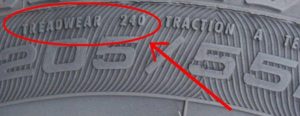Normally, used tires last 2-5 years if bought in adequate condition. A 2-year-old tire with no damage, patches, uneven wear, and with about 8/32” tread left, may last for good 5 years. A 4-year-old tire with 5/32” tread left, and without any significant plugs or cuts, may last a further 2 years. The lifespan of a used tire is extremely unpredictable, so any calculations are only estimates. The tire’s condition greatly depends on a number of factors.
What Influences How Long Used Tires Last?
The main factors influencing how long a used tire will last are:
- Age
- Treadwear
- Damage and repairs
- Maintenance.
Age
Any tire of 5 years or older has to be fully diagnosed every year and changed once deep cracks appear on its sidewalls or tread. So, if you’re looking for a used tire, a 2- or 3-year-old one will do fine. Tires over 10 years old can fail at any moment, as the rubber is too old to hold together. It starts to deteriorate the day the tire is released from the plant.
The National Highway Traffic Safety Administration and the Rubber Manufacturers Association don’t give an exact tire expiration age. However, in 2014, NHTSA released a document showing they are working on the issue. Vehicle manufacturers recommend changing tires once every 6 years, while tire manufacturers, like Michelin, say used tires last up to 10 years.
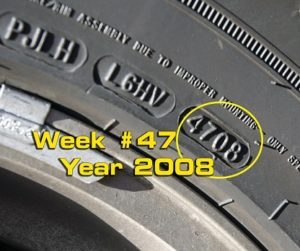
Determining Tire Age
You can determine tire age by looking at the DOT code on its sidewall. The last four digits are the week and the year the tire was manufactured. So, if you look at a tire with the code 4708, this will mean the tire was made during the 47th week of 2008. Such a tire is already too old to buy, unless it’s in perfect condition and you only need the tire for a maximum of one year.
You can learn more about tire date codes from this article.
Treadwear
Used tires may have up to 10/32” tread available, which is more than 90% of a new tire. Used tires last to 2/32”, which is the legal treadwear limit but now often considered too shallow. At this point, the braking distance increases, the vehicle’s response becomes worse, and the tires may fail. To get adequate service from used tires, aim at 7/32” or more. Learn more about used tire tread and other things you have to be aware of from this post.
Also pay attention to the Uniform Tire Quality Grade (UTQG) rating on the tire. There are three aspects: traction, treadwear, and temperature. The word “treadwear” and a three-digit number following, is what you should look for. The bigger the number is, the longer the used tires last, and the harder their rubber is. For example, treadwear 400 will mean every 1/32” wears every 8,000-10,000 miles. However, hard rubber provides a rather rough ride, while softer rubber performs better and soothes the move.
Uneven Wear
Irregular wear indicates a number of neglected vehicle issues. The wheels may be misaligned, the tires imbalanced, the suspension worn out, etc. Used tires last much less time if they are wearing unevenly. If one part of the tread wears beyond the legal limit, the tire’s performance will deteriorate dramatically. Plus, irregular wear may cause vehicle vibration, suspension failure, and other dangerous issues.
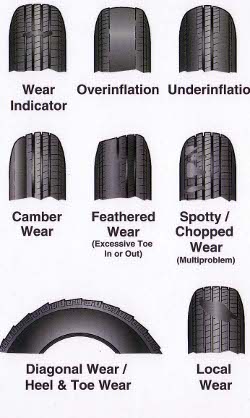
How Long Winter Tire Tread Lasts
It’s important to remember winter tires should be considered worn out at 4/32”. They catch onto snow with the help of special thin grooves called sipes. When these grooves become shallower, they don’t catch as successfully, so the tire will start to slide. Eventually, braking and cornering will become more difficult, and it will be easier to lose control of the vehicle.
So, used tires last for less time if they are for winter use, which you should consider when buying.
Damage and Repairs
The most frequent damage you need to pay attention to are cuts, holes from plugs, bulges, and cracks. While plug holes can be repaired, other damage are rarely reparable. There are also other serious issues to be aware of, such as:
- Exposed cords.
Severe irregular wear can make steel cords show on the surface. This is a serious issue that may cause tread separation. - Belt separation.
Bumps or bulges on the sidewall may indicate internal damage – specifically, belt separation. It usually happens when the vehicle drives over a large curb or pothole, at a high speed. - Bead chunking.
If you see chunks of rubber missing from the bead area, consider the tire dangerous. The bead may come off the rim at any moment, as the damage expands. Plus, such a tire will lose air more than the others, which may result in a blowout. - Liner damage.
Any damage to the liner may cause air loss, a sidewall collapse, etc. The tire may just fold and immediately fail. Also, if you find rubber dust inside the tire, it’s probably damaged, as the sidewalls were scrubbing themselves off at some point.
As for repairs, used tires last longer without them. However, if the tire is in perfect condition but has one repaired plug, it may still serve well. But keep in mind, other damage usually isn’t reparable, so if you see a sealed crack or cut, don’t buy such a tire.
Why Tires Get Damaged
Some of the reasons for premature cracking, cuts, bulges, and other damages are:
- Hitting obstacles, potholes, curbs
- Getting a nail/screw in the tire by driving over a it
- Driving in extreme temperatures
- Excessive exposure to ozone, oxygen, oil, harmful chemicals
- Rapid speed acceleration, hard cornering or braking
- Under-inflation, over-inflation
- Driving on a tire that ran flat
- Neglecting basic tire maintenance
- Improper usage (street tires off-road, winter tires in summer, etc.).
Maintenance
Both prior and future maintenance are crucial to how long used tires last. However, the necessary processes are the same:
- Tire balance
- Tire rotation
- Wheel alignment.
Tire Balance
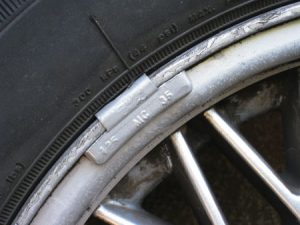
Many tires have stiff spots around their circumference. These spots must be balanced by putting small weights opposite them. You can perform such a procedure at home or go to a mechanic, where they will check the tire with a computer and balance it.
It’s an important part of tire maintenance, as imbalance may cause vibrations at speeds of 45 mph and more. The vibration can cause cupping or patch-wear – an irregular wear pattern that looks like scoops of rubber were taken out around the tire’s shoulder. So if you see a tire that has such wear, don’t buy it. You will have to wait for the tire to wear past the pattern, but by that time it may be worn out. Moreover, such a tire will produce noise and may also cause vibration.
Used tires last much longer when they are balanced after mounting. So, if you buy one, make sure you take it to a mechanic or find the stiff spots yourself. Learn more about tire balancing and how to perform it here.
Tire Rotation
Tire rotation is important, as it prevents uneven wear and helps used tires last longer. Weight distribution between the four main tires isn’t equal, due to the engine and transmission adding more mass. Consequentially, more weight is applied to one tire/pair of tires than to the others, due to which they wear unevenly. Tires with more mass on them wear faster, so tire rotation evens the wear.
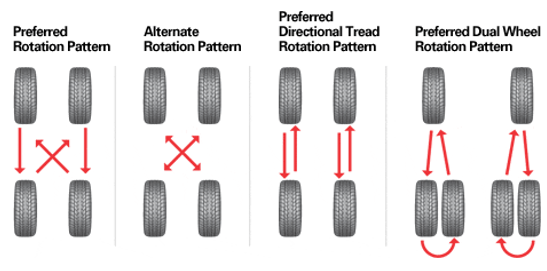
You can read more on the importance of tire rotation and ways to do it in this article.
Wheel Alignment
Wheel alignment sets each wheel parallel to the others and perpendicular to the road. This procedure is often confused with tire balancing, however, they are completely different processes. There are three angles in wheel alignment: camber, caster, and toe. Zero camber means the wheel is perpendicular to the ground. Zero caster means the steering axis is perpendicular to the ground. Zero toe means the wheels are parallel to each other.
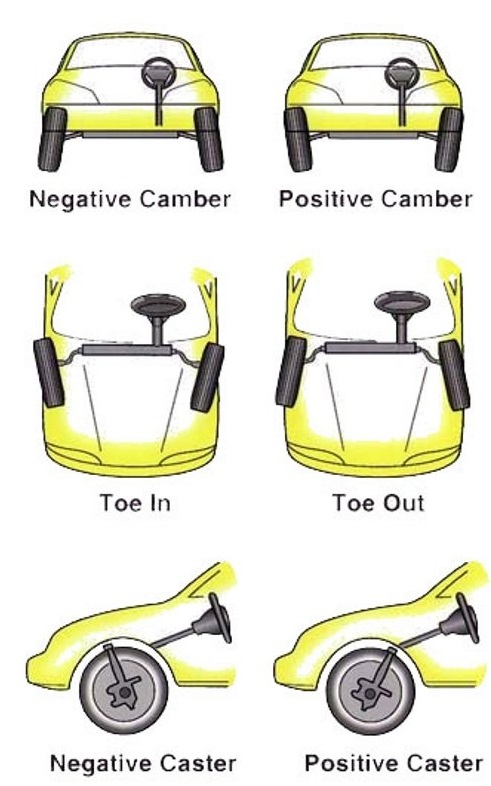
If any of the settings are out, tires wear unevenly, causing any of the aforementioned issues. Furthermore, wheel misalignment may cause suspension failure or premature wear.
NOTE: All these procedures are mentioned in the NHTSA special education campaign TireWise. On the special Maintenance page of the project, you can find out what’s important for your tires. All the rules usually apply to used tires, too.
How Long Used Tires Last if Unused
Stored used tires last for the same amount of time as tires you mount on your vehicle – a maximum of 10 years since the date of their manufacture. Rubber ages independently from usage of the tire, as the process of oxidation happens regardless of use.
There are two factors influencing the tire’s lifespan in this case:
- Environmental conditions.
Oxygen, ozone, ultraviolet light, and heat, make rubber age and dry. The more of these factors present, the faster the tire will become unfit for use. - Storage conditions.
The amount of light, temperature in the storage room, humidity, and tire deformation, influence tire condition. Exposure to the environmental conditions is also a part of storage. The hotter and lighter, the faster a tire ages. The more deformation there is (if tires lie in a pile or hang without rims), the faster the damage will occur.
Some used tires even last longer when actually used on a vehicle. When a tire is spinning, the oils within it start moving and lubricating the rubber from the inside. This prevents premature drying, making the tire last a bit longer. Therefore, you can choose used tires from different brands, for example Hercules, and not be afraid that their service life will be very short. If you want to know more about tire storage, read this article.
How to Make Used Tires Last Longer
There are some things you can do to prolong the life of your used tires. These are:
- Check air pressure regularly.
Some people recommend to check tire pressure every 3,000 miles, others insist on doing it weekly. It depends on the roads you drive on and the symptoms your tires have. For example, if you notice a tire loses air slowly yet faster than the others, check the pressure more often.
Proper inflation will improve your fuel efficiency by up to 3%. Nowadays, checking the inflation rate isn’t difficult, due to the Tire Pressure Monitoring System. It’s required on all vehicles manufactured after 2007.
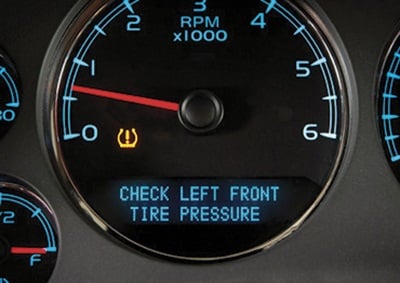
- Rotate your tires.
To make your used tires last longer, make sure you rotate them every 5,000-8,000 miles. Also, look at the tires thoroughly while rotating, as there may be minor damage that could become a serious issue. Remember to choose the right rotation pattern for the tires, depending on whether they are directional and same-sized. - Balance your tires.
Balance the tires every 3,000-6,000 miles, depending on how fast the tread wears. With time, weight distribution around the tire changes, requiring a new balance. It’s important to provide balance, to avoid vehicle vibration and other connected issues. - Don’t expose your tires to UV and ozone excessively.
Some exposure is inevitable, but make sure you control the climate in your garage, to make the used tires last longer. Storing tires in a cool dark place, in special tire totes, will help prolong their life. When not at home, make sure you park the car in shade. - Wash your tires.
Follow special techniques and rules of tire cleaning to achieve the best results. The easiest way to clean your tires is to change the water every time you wash or rinse one tire. Another rule is to dry clean them first and then apply water. Keep in mind, some cleaning substances promote tire drying, so make sure you choose the appropriate cleaners.
Buying Used Tires: Yes or No?
Used tires last almost as long as new ones if you check them for damage, uneven treadwear, etc., before buying. They will also save you money, as you can often find a set that usually costs $1000, for just $200. Furthermore, you will be helping the environment, as there are millions of reusable tires thrown away every year. There is more information on the benefits of buying used tires here.
However, keep in mind, used tires have no warranty, so you don’t know for sure what you are buying. Some sellers may lie about the maintenance they provided on the tires and any internal damage. The tire code may be scrubbed off, preventing you from learning its real age. Anything suspicious may mean there’s an issue with the tire you are about to buy, so be cautious. You can learn more about the drawbacks of buying used tires here.
Considering all pros and cons, the used tire market is still blooming. About 30 million tires are sold every year, which is only 10% of the whole tire market.

